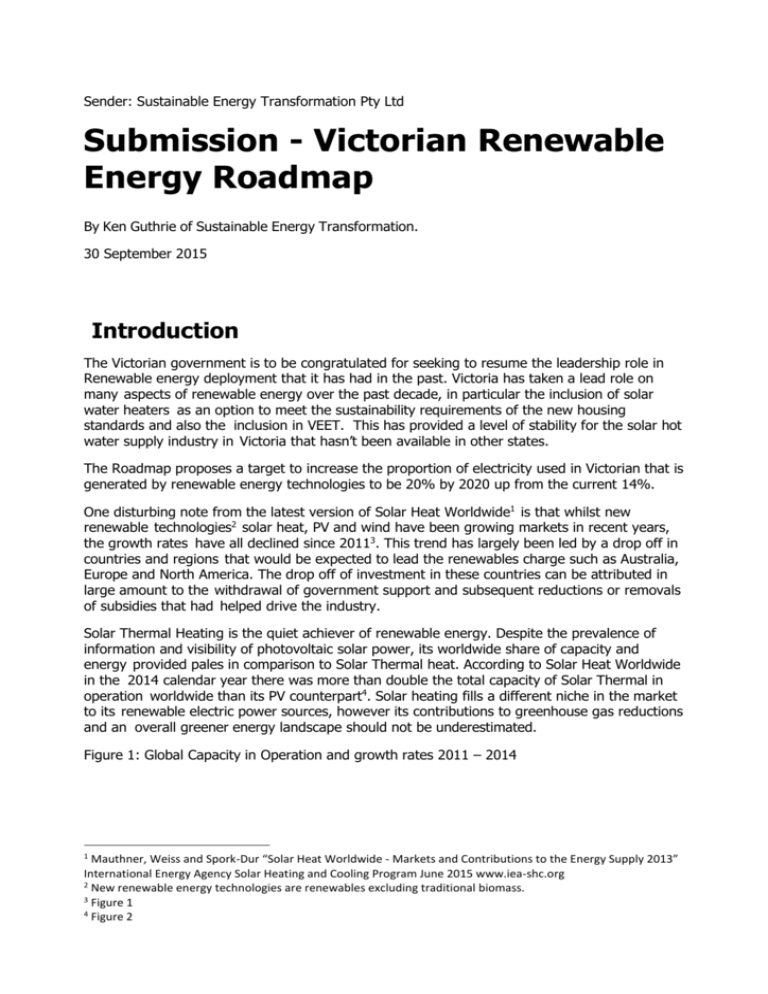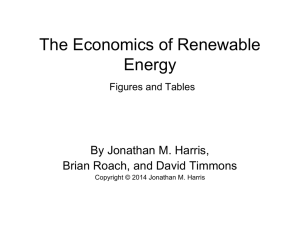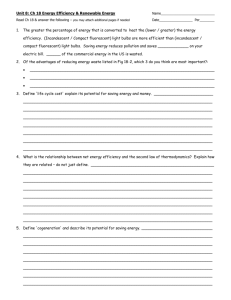Sustainable Energy Transformation (DOCX 427 KB)
advertisement

Sender: Sustainable Energy Transformation Pty Ltd Submission - Victorian Renewable Energy Roadmap By Ken Guthrie of Sustainable Energy Transformation. 30 September 2015 Introduction The Victorian government is to be congratulated for seeking to resume the leadership role in Renewable energy deployment that it has had in the past. Victoria has taken a lead role on many aspects of renewable energy over the past decade, in particular the inclusion of solar water heaters as an option to meet the sustainability requirements of the new housing standards and also the inclusion in VEET. This has provided a level of stability for the solar hot water supply industry in Victoria that hasn’t been available in other states. The Roadmap proposes a target to increase the proportion of electricity used in Victorian that is generated by renewable energy technologies to be 20% by 2020 up from the current 14%. One disturbing note from the latest version of Solar Heat Worldwide1 is that whilst new renewable technologies2 solar heat, PV and wind have been growing markets in recent years, the growth rates have all declined since 20113. This trend has largely been led by a drop off in countries and regions that would be expected to lead the renewables charge such as Australia, Europe and North America. The drop off of investment in these countries can be attributed in large amount to the withdrawal of government support and subsequent reductions or removals of subsidies that had helped drive the industry. Solar Thermal Heating is the quiet achiever of renewable energy. Despite the prevalence of information and visibility of photovoltaic solar power, its worldwide share of capacity and energy provided pales in comparison to Solar Thermal heat. According to Solar Heat Worldwide in the 2014 calendar year there was more than double the total capacity of Solar Thermal in operation worldwide than its PV counterpart4. Solar heating fills a different niche in the market to its renewable electric power sources, however its contributions to greenhouse gas reductions and an overall greener energy landscape should not be underestimated. Figure 1: Global Capacity in Operation and growth rates 2011 – 2014 1 Mauthner, Weiss and Spork-Dur “Solar Heat Worldwide - Markets and Contributions to the Energy Supply 2013” International Energy Agency Solar Heating and Cooling Program June 2015 www.iea-shc.org 2 New renewable energy technologies are renewables excluding traditional biomass. 3 Figure 1 4 Figure 2 Figure 2: Total Capacity and Energy Supplied for new renewable technologies This submission is from an individual however, it is based on the knowledge and information that I have gathered over many years in a number of national and international activities. I currently represent Australia, through the Australian PV Institute (APVI), on the Executive committee that oversees the work of the International Energy Agency Solar Heating and Cooling programme (IEA SHC)5. Since 2014 I have been the Chairman of that committee. I am also the Chairman of the ISO Solar Energy Committee and the Australian Standards Committee that covers solar heating and cooling technologies. This submission addresses the stated focuses of Roadmap: a) Identify policy which could be changed b) Provide information and support for the implementation of renewable projects c) Investigate actions for Victoria to take to attract investment and jobs 5 The IEA SHC is an international collaborative research program that covers solar heating and cooling technologies and a range of capacity building activities relevant to all solar technologies. Issues The two issues to be addressed are: 1. The supply technologies and the end-uses to be covered by the Renewable Energy Action Plan: and 2. The adequacy of the proposed target. Technologies and End uses Victoria’s Renewable Energy Roadmap sets out to identify and investigate ways in which Victoria can improve its standing on renewable energy and encourage investment. Given these goals it is disappointing to see Solar Thermal, which represents the largest installed capacity in operation worldwide of any new renewable source, barely mentioned throughout this report. It is understandable as this form of solar t is not easily metered into gigawatt hours produced, and as such its contribution is not readily visibly. However the energy saved, the related jobs in manufacturing, installation and monitoring and the benefits to the Victorian economy means this is not a field that can be overlooked. Victoria has taken the lead on solar hot water through its regulation requirements for new housing. This has seen the solar hot water industry achieve a level of stability not available elsewhere in the country. This is a situation not to be squandered. It puts Victoria on the same path taken by other jurisdictions which are showing positive results. For example, Israel has required solar water heaters to be installed on new buildings for the past 35 years. Currently this produces 3-4% of Israel’s total primary energy, saving over 20% of their electricity needs. It could be argued that solar thermal heat should be viewed as an energy efficiency process rather than a renewable energy source as the energy it produces is generally used on site and its implementation lessens the load on a system rather than creates power to be fed back into the grid system. However, whether it is viewed as a supply technology or an efficiency technology it does have the capacity to contribute to Victoria’s energy needs. It is estimated that over 50% of Victoria’s stationary energy is used as low to medium temperature heat. This is ideal for solar heating systems to deliver cost effectively. Victoria has a large manufacturing base in the food and beverage sector. For example 72% of the $13billion Australian dairy industry is in Victoria6. The food and beverage industry uses substantial amounts of heat in processing its products. In fact, 63% of processing energy in the dairy industry is used as heat. With the likely increase in gas prices in the near future7 and the large amount of gas used to provide heat for industrial processes in Victoria it is likely that solar and other forms of renewable heat will become more important for industry in this state. The IEA SHC program has undertaken a number of projects on industrial process heat and there are many successful examples of deployment internationally. Also the Australian Renewable Energy Agency (ARENA) has recently commissioned a study on the opportunities to replace gas in manufacturing and solar heat has been identified as a good opportunity to 6 David Barr Dairy Australia Victorian Energy Efficiency Summit August 2015. Australian Natural gas prices are approaching international parity due to offshore sales. International prices are linked to oil prices and recent oil price reductions have shielded Australian industry from ‘price shock’ however, this is unlikely to continue in the long term. 7 provide cost effective heat for low to medium temperature processes. There are a number of research programs (e.g. RMIT) and industry players in Victoria and elsewhere in Australia that have the wherewithal to enable the deployment of solar heat in the industrial sector in very cost effective ways. Solar thermal systems are manufactured in Australia including Victoria. A Victorian manufacturing plant focusing on collectors for industrial process heat could provide employment in the currently depressed Victorian metal manufacturing sector. The roadmap leaves open the opportunity for solar heat in a few places. Such as: Initiative 3 pg 17: “considerations will also be given…..heating markets….. to support their development Initiative 4 pg 17: discusses financial mechanisms which could be applied to onsite renewable heat supply. 6.2 initiative 1 pg.23: Developing industry plans for new technology – could lead to industries such as dairy and the potential of thermal. However, the roadmap focuses on Wind and PV which are undoubtedly important but not sufficient alone. The Renewables 2015 Global Status Report8 states that “Policymakers at all levels of government need to support the development of renewable heat given the large share of heat in final energy demand. Further development of integrated approaches for the heating and electricity sectors also can contribute to reducing grid pressure.” In summary, The Victorian Energy Action Plan should include energy delivered and used as heat from solar and other renewable technologies. Targeting Industrial Process heat will provide substantial employment benefits and benefits in the food and beverage sector. The adequacy of the proposed target The proposed target covers only the supply of electricity. Electricity is responsible for about 35% of Victoria’s Greenhouse emissions. The target to increase Victoria’s renewable electricity supply by 6% (ie from 14% to 20%) will result in a reduction in Greenhouse emission of slightly over 2% all else remaining the same. This is not insignificant, however, it is not sufficient for Victoria to claim any real leadership position nationally and certainly not internationally. For example, Renewable Energy Targets required in Europe cover heat supply and transport fuels as well as electricity. As such they are more comprehensive and provide a broader thrust for local manufacturing and jobs as the renewable technologies that generate electricity require large markets to be competitive internationally. The target needs to cover a wider range of energy use, and cover a longer time frame than the single 2020 target proposed. There needs to be targets for 100% renewables at some stage in the future. It is likely that international requirement will lead to 100% renewable energy being required mid-century. Consequently a 2030 target of 50% of electricity, 35% of heat and 30% of 8 Renewables 2015 Global Status Report REN21 transport fuel should be realistically considered and a 100% target for all end uses by 2050.








